#Niobid
Text
I like it when someone spam likes/reblogs my older posts because then I can go back and delete the ones where I was saying some really stupid shit.
#a lot of this is from when I was in my pjo phase#and some of them when I was new to mythology and had not fully grasped some nuances#like I really made a long ass post on why Apollo and Artemis were justified in killing the Niobides 😭#I'm...embarassed#I mostly share and make lighthearted posts now#but I have learnt to fully embrace the fact that my faves have done some unjustifiable stuff in some or the other accounts#still an Apollogist though#mine
27 notes
·
View notes
Text


ARTEMIS | Close-up, detail of:
Circular marble relief with Artemis and Apollo shooting arrows at Niobids
Roman [with "the figures appear to be copied from an Athenian work, perhaps a frieze, of 440-430 BC." - txt ©BM]
Diameter = 95 cm
Artemis figure = appx 22-24 cm
1 BC [probably]
Found in Italy.
The British Museum, London | BM
[Ground fl., Gallery G23]
Web : https://www.britishmuseum.org
FB : https://www.facebook.com/britishmuseum
IG, X : @britishmuseum
YT : https://www.youtube.com/user/britishmuseum
BM | Michael Svetbird phs©msp | 17|08|24 6400X4300 600 [I., II.]
The photographed object is collection item of BM
[Non-commercial fair use | No AI | Author rights apply | Sorry for the watermarks]
📸 Part of the "Reliefs-Friezes-Slabs-Sculpture" MSP Online Photo-gallery:
👉 D-ART:
https://www.deviantart.com/svetbird1234/gallery/72510770/reliefs-friezes-slabs-sculpture
.
#london#the british museum#british museum#roman#sculpture#relief#frieze#ancient sculpture#antiquity#art history#ancient#archaeology#museum#museology#heritage#antiquities#classical#mythology#artemis#niobids#άρτεμις#artemide#greek goddess#greek mythology#sculpture photography#museum photography#archaeology photography#art photography#bnw#michaelsvetbird
5 notes
·
View notes
Text

Fragment of a sarcophagus lid depicting the slaughter of the Niobids, Roman, late 2nd century AD
from The RISD Museum
147 notes
·
View notes
Photo

Greek Vase Painters & Potters
We know the names of some potters and painters of Greek vases because they signed their work. Generally a painter signed his name followed by some form of the verb 'painted', while a potter (or perhaps the painter writing for him) signed his name with 'made'. Sometimes the same person might both pot and paint: Exekias and Epiktetos, for example, sign as both potter and painter. At other times potter and painter were different people and one or both of them signed.
However, not all painters or potters signed all their work . Some seem never to have signed their vases, unless by chance signed pieces by these craftsmen have not survived.
Even in the case of unsigned vases, it is sometimes possible, through close examination of minute details of style, to recognize pieces by the same artist. The attribution of unsigned Athenian black- and red-figured vases to both named and anonymous painters was pioneered in the twentieth century by Sir John Davidson Beazley. Other scholars have developed similar systems for other groups of vases, most notably Professor A.D. Trendall for South Italian red-figured wares. For ease of reference Beazley and the others gave various nick-names to the anonymous painters whom they identified. Some are called after the known potters with whom they seem to have collaborated - the Brygos and Sotades Painters, for example, are named from the potters of those names. Other painters are named from the find-spot or current location of a key vase, such as the Lipari or Berlin Painters. A few, such as the Burgon Painter, take their names from former or current owners of key vases. Others are named from the subjects of key vases, such as the Niobid, Siren or Cyclops Painters, or else from peculiarities of style, such as The Affecter or Elbows Out Painters.
Continue reading...
59 notes
·
View notes
Text
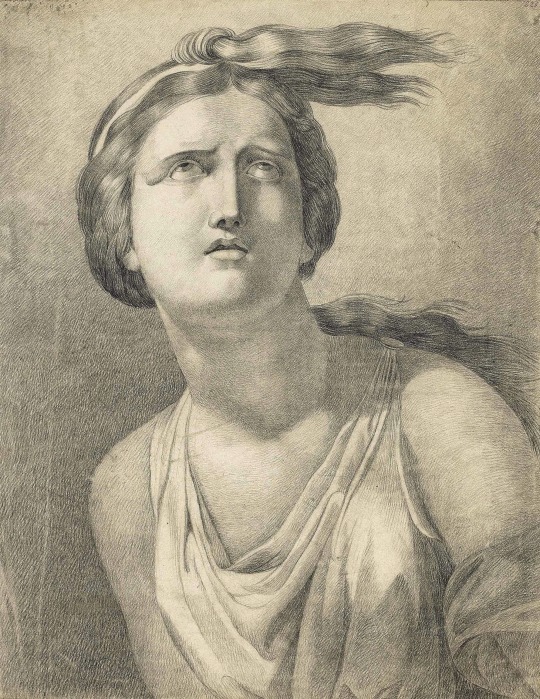
Bust of a Niobid, after the antique. 19th.century. Ludwig Schaller Austrian 1804-1885. black chalk on paper. http://hadrian6.tumblr.com
43 notes
·
View notes
Text
Pics I took at the National Roman Museum in Rome ☆

Augustus Pontifex Maximus (or Augusto di via Labicana)


Emperor Antoninus Pius & Discobolus Lancellotti

Niobid from Horti Sallustiani (so very gorgeous omg)

Sarcofago di Portonaccio (tho the picture ofc doesn't do it justice)
And bonus Antinoo spotting in the wild



Antinoo Ostia / Antinoo Tivoli, Villa Adriana / Antinoo Silvano
#Roma#ancient rome#roman empire#roman republic#sculpture#ancient history#antinous#emperor augustus#long post
10 notes
·
View notes
Text
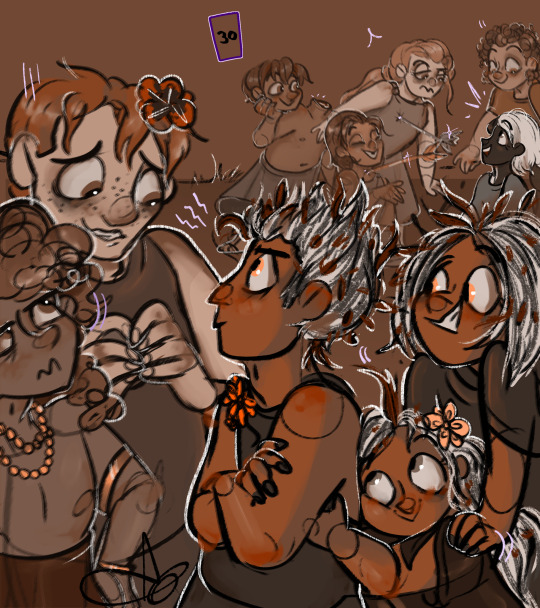
(April’s)Huevember - Day 30! THE LAST DAY!!
Featuring!!! …oh my god. last minute cram alert. from left to right:
(Front) • Cy, Mekon, Laphi, Annette, Lenore;;
(Back) • Itylus, Eupie, Cleodoxa, Meli, Nari;;
COLLAPSES THIS IS IT ITS DONE THE END!!! out with a bANG AND A GROUP SHOT?! also lmaoo I ended on Laphi last year’s Huevember too. NOTES!
in the foreground! Palace gardener, the half-owl god Laphi (previously mentioned multiple times this month as Boss ™ of the Flower Shades, also father of half bird thing Fjöer with Loki) - seen here wanting to re-kill one of his ditziest employees Flower Shade Mekon (the poppy flower) along with miserable bastard employee who’s not helping anything either Flower Shade Cy (the cypress tree)
… but it is sooo hard to appear properly angy and intimidating when 1, you are under five foot tall, and 2, two of your kiddo daughters are fully hanging off your back and trying to get your attention AHHH PLEASE. this must be a few years ago cause Lenore is 17 now! or maybe she’s super short? I’ve never drawn her older ovo
but obliviously in the background, Meli (Melinoe! the GOOD version, after OrigiMel died!) and friends are hanging out, it’s ghostie central anyway! Her best friend Nari (and Vali, off screen)- Loki’s late sons - plus one boy juggling act Itylus and his cousins, Eupie and Cleodoxa, who are two of the Famously Murdered Niobids. Cleo is a MISERABLE poltergeist but Meli’s too nice to shoo her away
this picture brings my grand final total of Elysium OCs featured this month to ‼️60 DIFFERENT CHARACTERS.‼️ or 61 if I count Meli and OrigiMel as different people. despite this WILDDDDD NUMBER I didn’t plan this well and in the end I’m missing JUST SIX?!?!?!?!?!?!? AAAAUUUUUUUGHHHHH I WAS SO CLOSE-
(six- not counting characters without designs yet, accessory OCs, or OCs currently being retconned and redone)
BUT! This month has been so so fun and i have had such a blast. thank you all for following along my delightful wheel of chaos.
stay tuned for ANYTHING DIFFERENT coming next!! once I give you all a break from me 😅😇🩷💗💖💓💖💓💗💖💗💖 TIL NEXT YEAR HUEVEMBER!!
Laphi, Lenore, Annette belong to @fenixethekid - everyone else is mine! And check this tag for all the huevember pics this month!! TELL ME YOUR FAAAAVE
#aceprilhuevember#Huevember#AceprilHuevember 2023#Huevember 2023#Huevember2023#my art#child death tw //#gore tw //?#just in case??
6 notes
·
View notes
Text
FRIENDS AS ARTWORKS PART THREE: for ves ( @gojovrse )

NIOBID KRATER by niobid painter
Attic red-figure calyx-krater
c. 460-50 BCE
54 cm x 56 cm
Currently located in the Musée du Louvre
It is a Krater, which is a Grecian bowl specifically designed for mixing wine and water. It was also specifically designed to mimic the calyx of a flower.
The different demarcated layers of the outer surface area of the piece, along with the intricate patterns on the cusp and base layers, displays the pot’s scenery and artistic content to the highest extent.
There’s two different sides of the vase with different stories, so I’ll explain them both.
Front Side of the Vase: It depicts Artemis and Apollo shooting the children of a mortal woman Niobe because she gloated about how her children were more beautiful than Leto, the mother of Artemis and Apollo. The two siblings tracked them down and then shot them in the name of their mother. To emphasize the difference in status, Artemis and Apollo have perfect side-profiles, while their victims have varied front and three fourths views. The figures have a stiffness to them that contradicts the brutal slaughtering. Apollo looks mechanical even though he’s literally drawing a bow. But my favorite part is the difference between the women and men on the front side. The women are all fully clothed, while the men are naked. It has been speculated that this is because Artemis was asexual; therefore, if a man were to have seen her naked then she would have blinded them. So, all of the women are clothed to mimic Artemis, while the men mimicked Apollo in the clothing sense.
Back Side of the Vase: It depicts a scene of various warriors, including the goddess Athena, surrounding Hercules. Athena can be identified by her spear and helmet. While Hercules is identified through his club and lion-skin, both of which are features common in his mythos. While back side contains multiple ground lines, Hercules sits smack in the middle of it, indicating an attempt to replicate realistic perspective in Grecian art. The entire depiction on the back side is in complete contrast to the front side, which I view as a stylistic choice. The choice displays the range of gods and their emotions.
Besides the Artemis fun fact, the “fun” part about the entire piece was that it depicted murder and worship on a wine brewer which is really funny.
4 notes
·
View notes
Text

Kind of a slutty way to lay dying ngl
(A dying Niobid 440-430 BC)
#hes like oooh nooo ive been struck! *wink wink*#tagammemnon#guess who as at the museum today!#greek art
18 notes
·
View notes
Text
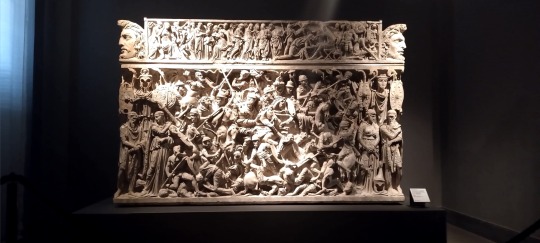
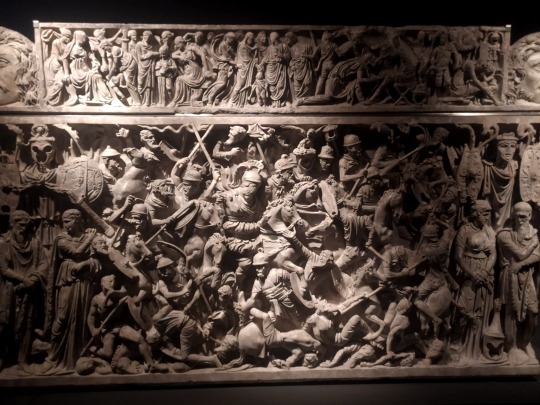

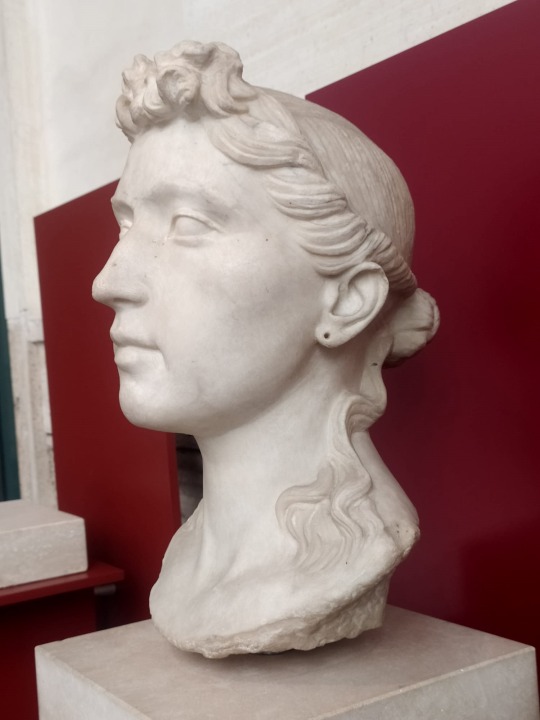


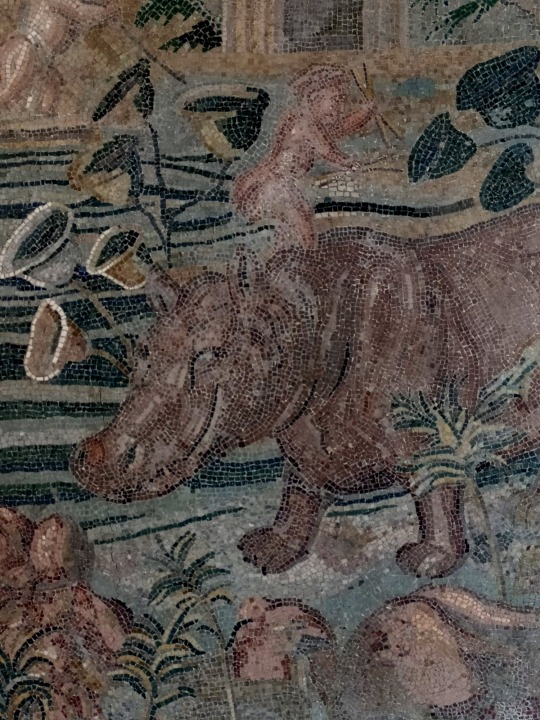
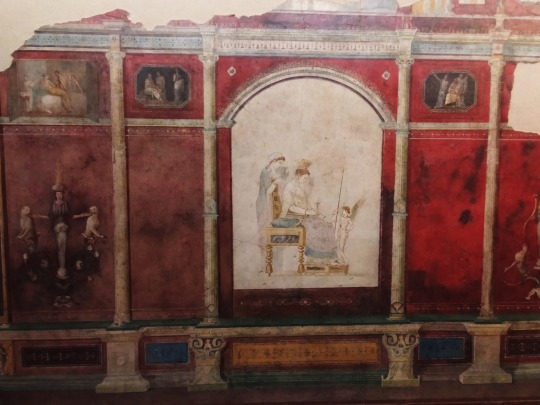
Palazzo Massimo - Rome
Inspired by the magnificent palaces of the 16th century, Palazzo Massimo was built between 1883 and 1887 by the Jesuit priest Massimiliano Massimo, based on a design by Camillo Pistrucci, to house the new Jesuit school. In 1981, the Palazzo was acquired by the Italian Government to become one of the new sites for the National Roman Museum. A radical renovation of the building was entrusted to Costantino Dardi and the Palazzo opened to the public in 1998. Since then, the original installation has been revised and adjusted on a number of occasions, interweaving the various threads of the exhibition using a design based on chronology and theme. By referring to the contexts in which the artefacts were found, this creates the suggestion that different works are jumbled together as in the bustling collections of the 16th century. Now, moving through the rooms of the Palazzo Massimo is like leafing through the pages of a wonderful book. Its four floors contain some of the greatest masterpieces of the entire artistic output of the Roman world: sculptures, reliefs, frescos, mosaics, stuccoes and sarcophagi, originating, like all of the treasures of the National Roman Museum, from excavations undertaken in Rome and the surrounding region from 1870 onwards. The route of the visit begins with the theme of the portrait and its evolution, from exclusive use by the most illustrious citizens in the Archaic Period to the widespread use of portraits among freedmen, from portraits of Greek origin, such as those of Alexander the Great, to those of simple Roman citizens eager for self-celebration at the end of the Republic, like the Tivoli General, and new forms of portraiture linked to the birth of the Empire, such as Augustus dressed as the Pontifex Maximus. Greek originals in marble, such as the Niobid from the Horti Sallustiani (Gardens of Sallust), and in bronze, including the Boxer at Rest and the Hellenistic Prince from the Baths of Constantine, are typical examples of the models of Greek art that came to Rome with the wars of conquest. Continuing the history of portraits in the Imperial Age, the first floor displays the Roman taste for reworkings and copies of ideal sculptures, like the Discobolus of Myron, presented in two well-known reproductions – the Lancellotti Discobolus and the Discobolus of Castel Porziano -, the Sleeping Hermaphroditus, the Aphrodite of Menophantos, and innumerable works depicting gods and mythological figures. However, sculpture also became a means of expression for celebrating victories at the borders of the Empire, such as the monumental Portonaccio sarcophagus, and a method for paying tribute to the greatness of well-known figures in the society of the late Roman Empire, as can be seen from the Acilia and Annona Sarcophagi. The second floor of the Palazzo is dedicated entirely to frescos, stuccoes and mosaics. One element that is fundamental in fully grasping the taste and aesthetic sense of the Roman aristocracy is the superb wall decorations of major archaeological complexes, such as the Villa di Livia in Prima Porta, the Villa Farnesina in Trastevere and the Villa di Termini. The basement level offers a selection from the collections from the National Roman Museum’s Coin and Medal Collection and is dedicated to the economy and the use of money, interpreted through an exhibition of coins, jewellery, precious ornaments and documents relating to the daily cost of life.
#rome#roma#italy#italia#travel#ig#art#photography#love#igersroma#picoftheday#romeitaly#photooftheday#instagood#architecture#travelphotography#lazio#europe#visitrome#igersitalia#paris#history#photo#like#vatican#travelgram#london#instagram#follow#italian
2 notes
·
View notes
Text

Bruno Innocenti, Niobide, bassorilievo in terracotta steccata
La Niobide colpita da una freccia si collega al complesso di opere che Bruno Innocenti realizzò intorno ai temi classici e mitologici a partire dal grande complesso monumentale Apollo e le Muse, sette sculture in gesso e stucco realizzate nel 1933 per l'Arcoscenio del Teatro Comunale di Firenze appena inaugurato, che oggi si trovano, dopo i restauri del 1960, nel foyer dello stesso teatro, e costuiscono la più monumentale opera di scultura del Novecento toscano.
In questa Niobide lo scultore unisce al tema classico la sua visione del nudo femminile, realizzata attraverso un modellato plastico raffinatissimo e permeata di un lirico erotismo
Bibliografia : Marco Fagioli, Bruno Innocenti, scultore tra mito e liricità, Aión, Firenze, 2009
Bibliografia di riferimento
Marco Fagioli, L'Erinni di Bruno Innocenti. L'anima e la forma, Aión, Firenze, 2006
8 notes
·
View notes
Text
33. Niobides Krater

By the anonymous vase painter of Classical Greece known as the Niobid Painter
Classical Greece
Created c. 460-450 BCE
Clay, red-figure technique (white highlights)
2 notes
·
View notes
Text

"Wounded Niobid"
Bronze
Camille Claudel: 1864-1943
Getty Museum
Los Angeles, California
Gouache
6.1x8.3x2 Etude Butterfly Sketchbook
Sketched live on location 2:00 PM to 2:31 PM
Saturday July 13 2024
#油彩画#水彩画#sketch#croquis#cityscapepainting#sketchbook#citysketch#スケッチ#dessin#gouachepainting#urbansketchers#gouachelandscapepainting#アート#イラスト#グラフィック#デザイン#travelsketch#만화#urbansketching#urbansketcherslosangeles#urbansketchersnoc#usknorthoc#uskla
0 notes
Text
Discover the Diverse Art Forms of the Uffizi Gallery
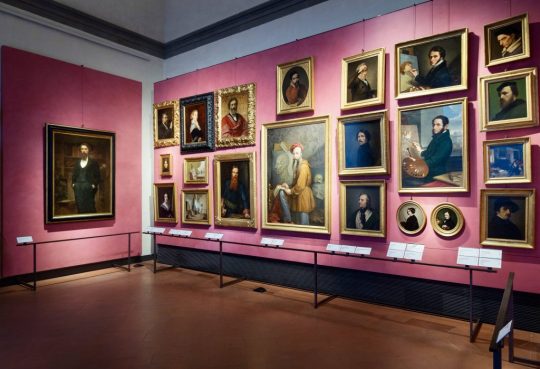
To witness an extensive collection of Italian Renaissance art, the Uffizi Gallery in Florence is the best place to visit. It houses a wide variety of art forms by renowned artists. Not just paintings, the gallery showcases art in different forms. These include:
Paintings: There are numerous Renaissance paintings displayed in the Uffizi Gallery. Some notable works include:
"The Birth of Venus" by Sandro Botticelli
"Annunciation" by Leonardo da Vinci
"Doni Tondo" by Michelangelo
"Adoration of the Magi" by Leonardo da Vinci
"Primavera" by Sandro Botticelli
Sculptures: At the gallery, you will witness an impressive array of classical and Renaissance sculptures. The most stunning creations include:
"The Medici Venus": It is a classical Greek statue of Venus, the goddess of love.
"The Wrestlers": It shows two athletes engaged in a wrestling match. It is a Roman copy of a Greek original.
"Hermaphrodite": Another Roman copy of a Greek original showing Hermaphroditus, the child of Hermes and Aphrodite.
"Laocoön and His Sons": This sculpture shows the Trojan priest Laocoön and his sons being attacked by sea serpents. It is a Roman copy of a Hellenistic original.
Drawings and Prints: The Uffizi Gallery displays an extensive collection of antique drawings and unique prints. These drawings show the preliminary sketches and detailed studies of various artists. These include:
Leonardo da Vinci’s Sketches: These are preparatory drawings and studies by Leonardo da Vinci. These provide insight into his creative process.
Michelangelo’s Drawings: These collections of Michelangelo’s drawings showcase his powerful draftsmanship and skill in capturing the human form.
Raphael’s Studies: Raphael’s preparatory drawings reflect the refined technique used in his final works.
Antiquities: Numerous ancient Roman statues and artifacts are also displayed in the gallery illustrating Renaissance art from the ancient times. Some of them are:
"The Medici Vase": It is a grand and intricately decorated marble vessel used for mixing wine and water. It is a bowl made in classical Greek style.
"The Niobid Group": These are Roman statues that are copies of Greek originals. These depict the tragic myth of Niobe and her children being punished by the gods.
"The Idolino of Pesaro": It is a bronze statue of a young male made in classical Greek style.
"The Medici Torso": It is a fragmentary statue of a muscular structure and dynamic pose typical of classical sculpture.
The Uffizi Museum is an artistic wonder in itself displaying the largest collection of the Renaissance art by gifted artists and sculptors. This gallery showcases the development of art from the Middle Ages to the Baroque period.
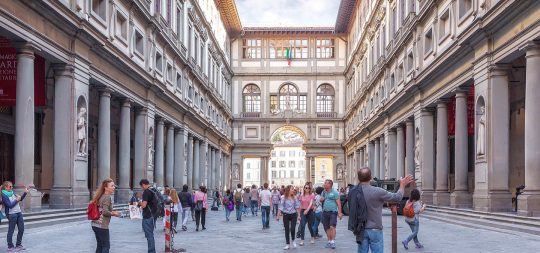
Quick tips for Uffizi Gallery Florence visitors:
If you are planning to visit this place, save your energy and time by booking Uffizi Museum Tickets in advance. The place observes thousands of visitors on a daily basis so you may have to stand in a long queue to book your tickets. But with advanced booking, you can choose the day and time you want to visit.
Book a guided tour. Though you can explore the museum on your own, you may get to know several less-known facts about it when you are accompanied by a knowledgeable tour guide. You can request him to communicate in the language you prefer so that you don’t miss any of the significant works displayed here.
Weekdays especially Wednesday and Thursday are the best days to visit the gallery. Mornings are usually less crowded. Arrive early to avoid long Uffizi Museum Tickets queues.
The museum has a cafeteria at the end of the galleries on the first floor from where you can get a cappuccino and enjoy a panoramic view of the area.
1 note
·
View note
Text

object type / vase shape: attic red figure bell-krater with fragmetary bronze lid
- description side A: bearded old man in mantle standing with sceptre (king Keleos of Eleusis?), Triptolemos wearing a laurel wreath, sitting with sceptre and phiale in his winged chariot, Persephone with oinochoe and torch, Demeter with sheaves of corn, Hermes - side B: doric column, goddess holding wreath, Zeus with sceptre and phiale sitting on throne, Nike or Iris with oinochoe, goddess (Hera) with sceptre and phiale sitting on stool - production place: Athens - painter: Niobid Painter (middle work) - period / date: early classical, ca. 460 BC - material: pottery (clay) - findspot: Orvieto - museum / inventory number: Perugia, Museo archeologico nazionale dell'Umbria 846 - bibliography: John D. Beazley, Attic Red-Figure Vase-Painters, Oxford 1963(2), 603, 34- Please note: The above museum permits photography of its exhibits for private, educational, scientific, non-commercial purposes. If you intend to use the photo for any commercial aime, please contact the museum and ask for permission.
ArchaiOptix
Creative Commons Attribution-Share Alike 4.0
Niobid Painter ARV 603 34 Triptolemos with Demeter Persephone Hermes and Keleos - Zeus and gods
1 note
·
View note
Text

Giocatrici di astragali
The Astragali Players
This piece from Herculaneum (1st century AD) depicts Phoebe trying to pacify Latona and Niobe while two Niobids - Hilearia and Agle - play knucklebones, oblivious to their imminent doom.
The information is derived from inscriptions made by the painter, Alexander of Athens.
Currently at the National Archaeological Museum, Naples.
Source: 🏺
#LATONA 🌻#ANTIGÜEDADES 💎#UPD: pinakes not frescoes* I was sleep deprived#greek mythology#ancient art#art#herculaneum#alexander of athens#phoebe#niobe#latona
98 notes
·
View notes